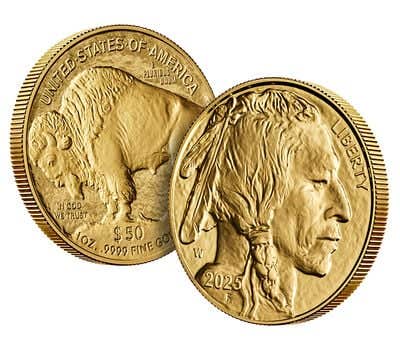Money must keep its value
The world’s central banks are likely to be net buyers of gold in 2009 after spending two decades as net sellers.
This article was originally printed in the latest issue of Numismatic News.
>> Subscribe today!
The world’s central banks are likely to be net buyers of gold in 2009 after spending two decades as net sellers. For 18 years, central banks have been net sellers of gold reducing their holdings by 10 percent. India’s $6.7 billion purchase of 200 metric tons of gold from the International Monetary Fund last month, absorbing half the amount of IMP put up for sale, was the largest purchase by a central bank in 30 years.
This was reported by The Wall Street Journal on Nov. 11, 2009.
This news report illustrates two points. First, that money must be a store of value to function properly, and secondly, that the world-wide fiat money experiment is failing; an experiment that may be dated to 1971 when the world reserve currency, the U.S. dollar, was severed from gold. That means that from 1971 foreigh nations could no longer exchange their paper dollars for gold. This was a unilateral repudiation by the U.S. of the 1944 Bretton Woods agreement.
In his July 13, 2010, Viewpoint, VKB gives his definition of money and notes, “... there is nothing in there about a store of value, a former monetary attritue that has been intentionally abandoned for almost 40 years.”
VKB later adds that, “Store of value is no longer an attribute of money, but rather one of investments. I thought we all knew that.”
That simply is not true and is easily explained. Money must be a store of value. Money must retain value over time. The question is, how much value should it retain over what period of time?
When money is not immediately spent, one needs assurance that it retains purchasing power. For how long? One day, a week, a month, a year a decade, a century? For nations running trade surpluses, they want their money to retian value for years or they will spend that money buying real assets.
In the earlier cited WSJ article, it said, “Wei Benhua, a former Chinese official, was cited by Chinese language magazine Caijing on Monday as saying China, Brazil or Russia may follow India in buying IMF gold.” The article also noted that, “With a net inflow of dollars and euros every month, central bankers in these countries are worried about the growing exposure to these currencies and have the most desire to diversify into other assets.”
The failure of fiat monies to retain value has resulted in their destruction. The U.S. Continental Currency, French assignats of the 1790s, Germany of the 1920s, right through to Zimbabwe of today, the common thread of fiat money is that monetizing debt by government is too tempting and easy.
The U.S. dollar was severely devalued in the 1970s. From the U.S. Bureau of Labor Statistics, a 1972 dollar by 1980 had lost more than 47 percent of its value.1 By losing almost half of its value over seven years, severe economic dislocation was caused by U.S. money not retaining its value. Savings were destroyed, thrift discouraged and businesses were unable to properly expense long-term costs.
In the Federal Reserve Bank of Minneapolis 1979 Annual Report, it comments on the many problems that infation causes. “Inflation gives people incentives to use their time and physical goods in less productive ways. It does this by making money less desirable as a means of exchange and a store of value.”
The FRB also comments on the political manipulation and how it benefits recipients of government spending:
Currently, it seems safe to assume that the U.S. Government will not pay off its debt. Since the 1960s it has not done so, and it appears to have no intention of doing so. When the Federal Government runs a deficit, it simply prints and sells more bonds. Federal bonds are nothing more than an alternative form of currency – they are promises to deliver currency in the future. Like currency, these bonds are pieces of paper backed by nothing tangible; they are fiat paper. When the government has no intention of retiring its debt, there is little difference between currency and bonds; both are money. In this circumstance, any increase in the deficit is an inflation tax.
The FRB continues that:
What is not often acknowledged, though, is that thise (inflation) is also a tax. When the government prints more paper the government benefits and the private sector pays. Government can print paper for virtually nothing and use it ... to acquire other real resources from the private sector. An increase in federal paper – currency or bonds – is thus really an inflation tax.
As the FRB notes, “by making money less desirable as ... a store of value,” people are given incentives to use their money in less productive ways. “Store of value” can be used in this context as “saving” and savings distinguished from investment in that the goal is to put money aside simply to forgo current consumption for the future and forgo profit in exchange for safety, which includes retention of value. Thrift is discouraged when people can’t simply save their money to retain value, but must make relatively complicated and risky investments.
VKB comments that, “The keen observer will correctly note that by definition, a one ounce gold Eagle is worth, as money, $50, not a number somewhat north of $1,200.” This definition is of no practical value. Sir Thomas Gresham, a prosperous businessman and financial advisor to Queen Elizabeth I of England (1558-1603) said it best. In arguing for sound money, he said it was better to “bring the base money into fine ...,” for “the exchange is the chiefest thing only above all others.”2 No one is going to exchange a one ounce gold Eagle for $50 of goods, the exchange will be made for more than $1,000 of goods.
Stated value was often ignored when gold and silver coins were in circulation and would pass at a premium or discount depending on the coin’s intrinsic metal value. U.S. gold coins immediately prior to 1834 and silver coins immediately prior to 1853 either passed for a premium or were melted for metal content. Gresham’s most well-known observation, that bad money drives the good out of circuclation, was seen in the U.S. in the late 1960s when 90 percent silver coins were taken out of circulation.
VKB wrote that I don’t recognize the “fundamental transforming moment” of the floating currency market that began in the early 1970s. I do. Fiat paper money is not new, Marco Polo in the 13th century remarked on the Chinese use of it. It wasn’t until the late 1700s that major western nations began the use of fiat paper. What changed was that when the U.S. ended the convertibility of the dollar to gold, a new system had to be created and the “floating fiat” system was the way to ensure accountability in international finance. It was the first time all leading economic world powers were on a fiat money system.
VKB worries about bad public policy resulting from the sound money policies I support. Its’ relevant history to note the economic power by the early 20th century. The U.S. dollar was backed by gold until 1971 and gold was in circulation until 1933. Britain, the dominant economic power in the 19th century, used gold money. Gold helped, not hindered, the U.S. economy by providing stable money and restraining government from excessive debt. Those who argue that gold has a role in today’s monetary system argue from what history teachus us. It’s not why the Chinese, Indian and other nations are including gold in their foreign exchange reserves.
Over the year, Barron’s, the WSJ and Investor’s Business Daily have had articles on the value of gold in a monetary system and on how to reintroduce its use. Articles came from both staff and non-staff. Writes, especially in Barron’s, are successful investment fund managers who argue for gold as a hedge against financial instability because of excessive debt by governments worldwide which has and will continue to result in currency debasement and defaults.
My views are an evaluation on what works and what doesn’t.
Footnotes:
1 Chicago Tribune, Jan. 26, 1980. 2 “The English Experience” by John Bowle, C-1971.
** Don Markay is a hobbyist from Fargo, N.D.
The Everything American History Book
Starting with the first Viking explorations and continuing to the present day, The Everything American History Book, 2nd Edition takes you on a thrilling tour through history.
More Coin Collecting Resources:
• Subscribe to our Coin Price Guide, buy Coin Books & Coin Folders and join the NumisMaster VIP Program









